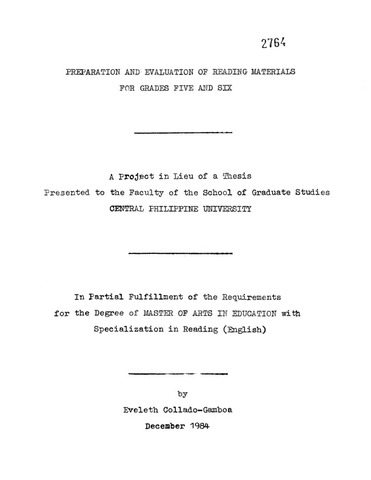Preparation and evaluation of reading materials for grades five and six

Page views
483Petsa
1984May-akda
Tagapangulo ng Panel ng Depensa
Magbahagi
Metadata
Ipakita ang buong tala ng item
Abstract
Reading plays a very important role in man's drive towards modernization. People in all walks of life have to do a lot of reading in order to satisfactorily adjust to an ever-changing society. It is through reading that man may change his own outlook in life, broaden his own interests, aid in the reconstruction of experience, give himself a deeper insight into the reason for things as they are, refine his own tastes, modify his own behavior, stimulate his own intellectual and emotional growth, and, in various ways, promote the development of a rich and stable personality. Thus, the need for the development and mastery of reading skills by the child from the time he first enters school has been declared and greatly emphasized.
Analysis of the present situation in our school system, however, shows that children, particularly in the intermediate grades, have reading difficulties.
Project SOUTELE, which ascertained the outcomes of elementary education and determined the factors that affect these outcomes, reported that, regarding scholastic achievement, the sixth graders across the nation seem to have achieved the least in the areas that are traditionally called the 3R‘s and that, while the sixth graders consistently score higher than the fifth graders in the scholastic achievement tests, the differences are not statistically significant. Others studies that have been conducted during the recent years have found out that our pupils have not performed according to their grade level. Barrios, in her study of oral reading difficulties of grades five and six pupils in the Division of Roxas City, concluded that at the start of the school year the average reading level of children in grades five and six was that of the children in the third and fourth grades, a reading performance which is behind by two years.
Reading difficulties have been attributed to several factors. Monroe and Bachus identify the following: 1) constitutional factors like visual defects and weak or infirm physical condition, 2) intellectual factors such as verbal disabilities and peculiarities in modes and thoughts, 3) certain emotional factors, 4) educational factors which include deficiency in readiness, poor adjustment of materials and methods to the child’s needs, lack of interest in reading and inadequate provisions /sic/ or attention to pupils who are encountering difficulties, 5) environmental factors like little or no motivation or encouragement from the home or poor rapport between parent and child.
Castano’s study, which dealt with the reading interests and tastes of children in Lakandula Elementary School, Manila, showed that in general the pupils under study had the desire to read. However, there were indications that pupils did not read much, that their reading interests were limited in scope and that most of the materials they read showed an appalling lack of taste. The possible causes for this low level of reading interest and taste were inaccessibility of reading materials in the home, poor attitude in the home towards reading, inability to read on the part of the 35 per cent of the pupils under study, unavailability of a wide range of materials from all content fields, out— of-school factors that form reading interest, and failure of the school to make a wholehearted attack upon this problem.
It is therefore safe to conclude that availability of proper reading materials is one of the determining factors for successful reading. Reading materials should not only be varied and interesting in themselves but also cater to the needs, interests, and preferences of individual readers.
Purpose of the Project
Children who come to our schools have their own individual peculiarities. The more complex a skill they have to learn, the more will differences in ability tend to show up. Since reading is a highly complex skill, children therefore differ greatly in their reading needs and achievement.
Because of the foregoing observations, it is the aim of this project to produce a set of reading materials and designed to meet some needs of the intermediate pupils.
It is hoped that these materials will enable the teachers to provide for the individual differences among the children of this level and to suggest enrichment activities that will sharpen their reading skills. It is also hoped that while using these materials, the grade five and six pupils will learn to work well either independently or in a group, at the same time that they learn some of the basic skills in reading.
Paglalarawan
Introduction and statement of the problem
Mungkahing Sipi
Gamboa, E. C. (1984). Preparation and evaluation of reading materials for grades five and six (Unpublished Master’s special paper). Central Philippine University, Jaro, Iloilo City.
Uri
Special paperMga Paksa
Kagawaran
School of Graduate StudiesDegree
Master of Arts in Education with specialization in Reading (English)Lokasyon ng Istante
GSL Theses 378.242 G114
Pisikal na paglalarawan
160 leaves

